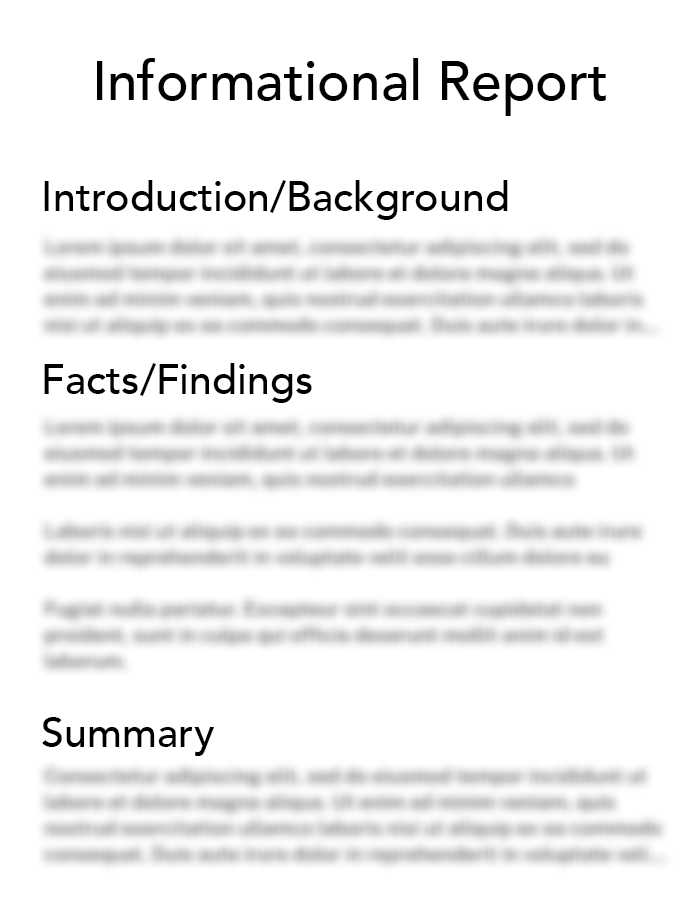Organizing based on Audience Analysis
Reports require you to analyze the audience the same way that you would for any written communication. The difference lies in the depth of information needed. Thinking about your audience, or the stakeholders, is one of the most important aspects when creating a report. Remember to consider direct, indirect, and remote stakeholders.
To determine which types of sections you should use in your informal report, think about the purpose of the report. These sections can take inspiration from the standardized sections used in formal reports as they relate to the needs of your audience.
Organizing for Neutral or Positive Reactions

If your audience, for example, is expected to react neutrally or positively to your message, then your conclusion or recommendation should be offered near the beginning of the report.
- First, you would write the introduction, background, or problem section.
- Next, come your conclusions or recommendations. These are backed up by the support or reasons section, which details facts, data, or findings.
- The final section is typically some sort of further discussion, analysis, or summary.
Remember that introducing these sections with a descriptive heading can help your readers, especially if the sections consist of multiple paragraphs.
Organizing for Negative Reactions
If the audience is expected to react negatively to your message, then the conclusion or recommendation is offered towards the end of the report. This alternate organization allows the reader to reach a similar conclusion to yours after reviewing the research and logic offered.
- First, you would write your introduction, background, or problem.
- The next section will be the support or reasons section, which details facts, data, or findings that led you to your conclusion.
- Next, you would include a discussion, analysis, or summary. This section is where the logical or emotional arguments that may influence the reader’s understanding are made.
- Your report then concludes with your conclusions or recommendations.
Remember that introducing these sections with a descriptive heading can help your readers, especially if the sections consist of multiple paragraphs.

Formatting the Report
While informal reports may not use extensive or standardized labeling of sections, nor do they have a required length of individual sections, each section has a unique purpose. However, these “sections” may be a couple of paragraphs rather than fully separated sections with their own headings. As the report starts to exceed a page or two, headings will provide a tremendous benefit to the reader, and you, as the reader will better understand and retain your main ideas.
A Quick Comparison: Using Headings?
Take a look at these two sample texts to compare the structure of an informal report without headings and an informal report that uses headings. Note that these examples only show the formatting of a report, not the ideal way to write one.
| No Headings | Using Headings |
|---|---|
|
General Store is opening a new location in Q4 of this upcoming year. There are three potential locations for this new store. In my research, I found that location one is in a poorly trafficked area, but is more affordable. Location two is in a highly trafficked area, but is out of the current budget. Location three is just right. After this research, I can conclude that General Store should open its new store at location three. |
BackgroundGeneral Store is opening a new location in Q4 of this upcoming year. There are three potential locations for this new store. FindingsLocation one is in a poorly trafficked area, but is more affordable. Location two is in a highly trafficked area, but is out of the current budget. Location three is just right. RecommendationGeneral Store should open its new store at location three. |
Headings can be a useful tool for helping your readers navigate directly to the information they want. Notice that the headings catch your reader’s eye much more easily than phrases such as “in my research . . . “
Direct stakeholders are those initially impacted by what you write.
Indirect stakeholders are those that are not impacted until a later time.
Remote stakeholders are not affected until far into the future.